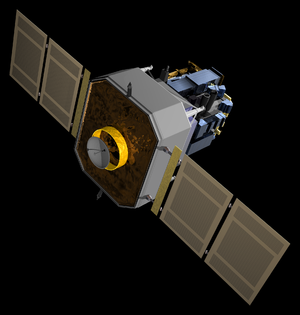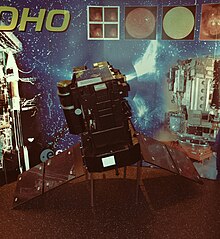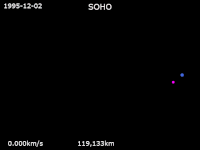Solar and Heliospheric Observatory
 SOHO satellite | |||||||||||||||||||||||||||
| Names | SOHO | ||||||||||||||||||||||||||
|---|---|---|---|---|---|---|---|---|---|---|---|---|---|---|---|---|---|---|---|---|---|---|---|---|---|---|---|
| Mission type | Solar observation | ||||||||||||||||||||||||||
| Operator | ESA/NASA | ||||||||||||||||||||||||||
| COSPAR ID | 1995-065A | ||||||||||||||||||||||||||
| SATCATno. | 23726 | ||||||||||||||||||||||||||
| Website | soho nascom.nasa.gov | ||||||||||||||||||||||||||
| Mission duration | 2 years (planned) 28 years, 7 months and 14 days(in progress) | ||||||||||||||||||||||||||
| Spacecraft properties | |||||||||||||||||||||||||||
| Bus | SOHO | ||||||||||||||||||||||||||
| Manufacturer | Matra Marconi Space | ||||||||||||||||||||||||||
| Launch mass | 1,850 kg (4,080 lb)[1] | ||||||||||||||||||||||||||
| Payload mass | 610 kg (1,340 lb) | ||||||||||||||||||||||||||
| Dimensions | 4.3 × 2.7 × 3.7 m (14.1 × 8.9 × 12.1 ft) 9.5 m (31 ft) with solar arrays deployed | ||||||||||||||||||||||||||
| Power | 1500watts | ||||||||||||||||||||||||||
| Start of mission | |||||||||||||||||||||||||||
| Launch date | 2 December 1995, 08:08:01UTC | ||||||||||||||||||||||||||
| Rocket | Atlas IIAS(AC-121) | ||||||||||||||||||||||||||
| Launch site | Cape Canaveral,LC-36B | ||||||||||||||||||||||||||
| Contractor | Lockheed Martin | ||||||||||||||||||||||||||
| Entered service | May 1996 | ||||||||||||||||||||||||||
| Orbital parameters | |||||||||||||||||||||||||||
| Reference system | Sun–Earth L1orbit | ||||||||||||||||||||||||||
| Regime | Halo orbit | ||||||||||||||||||||||||||
| Perigee altitude | 206,448 km (128,281 mi) | ||||||||||||||||||||||||||
| Apogee altitude | 668,672 km (415,494 mi) | ||||||||||||||||||||||||||
| |||||||||||||||||||||||||||
 SOHO mission patch | |||||||||||||||||||||||||||
TheSolar and Heliospheric Observatory(SOHO) is aEuropean Space Agency(ESA) spacecraft built by a European industrial consortium led byMatra Marconi Space(nowAirbus Defence and Space) that was launched on aLockheed MartinAtlas IIASlaunch vehicleon 2 December 1995, to study theSun.It has also discovered over 5,000comets.[2]It began normal operations in May 1996. It is a joint project between theEuropean Space Agency(ESA) andNASA.SOHO was part of the International Solar Terrestrial Physics Program (ISTP). Originally planned as a two-year mission, SOHO continues to operate after over 25 years inspace;the mission has been extended until the end of 2025, subject to review and confirmation by ESA's Science Programme Committee.[3]
In addition to its scientific mission, it is a main source of near-real-time solar data forspace weatherprediction. Along withWind,Advanced Composition Explorer(ACE), andDeep Space Climate Observatory(DSCOVR), SOHO is one of four spacecraft in the vicinity of theEarth–SunL1 point,a point of gravitational balance located approximately 0.99astronomical unit (AU)from the Sun and 0.01 AU from the Earth. In addition to its scientific contributions, SOHO is distinguished by being the first three-axis-stabilized spacecraft to use itsreaction wheelsas a kind of virtualgyroscope;the technique was adopted after an on-board emergency in 1998 that nearly resulted in the loss of the spacecraft.
Scientific objectives[edit]
The three main scientific objectives of SOHO are:
- Investigation of the outer layer of the Sun, which consists of thechromosphere,transition region,and thecorona.The instruments CDS, EIT,LASCO,SUMER, SWAN, and UVCS are used for thissolar atmosphereremote sensing.
- Making observations ofsolar windand associated phenomena in the vicinity ofL1.CELIAS and COSTEP are used for "in situ"solar wind observations.
- Probing the interior structure of the Sun. GOLF, MDI, and VIRGO are used forhelioseismology.
Orbit[edit]
The SOHO spacecraft is in ahalo orbitaround theSun–EarthL1 point,the point between the Earth and the Sun where the balance of the (larger) Sun's gravity and the (smaller) Earth's gravity is equal to thecentripetalforce needed for an object to have the sameorbital periodin its orbit around the Sun as the Earth, with the result that the object will stay in that relative position.
Although sometimes described as being at L1, the SOHO spacecraft is not exactly at L1 as this would make communication difficult due to radio interference generated by the Sun, and because this would not be astableorbit. Rather it lies in the (constantly moving) plane, which passes through L1 and is perpendicular to the line connecting the Sun and the Earth. It stays in this plane, tracing out an ellipticalhalo orbitcentered about L1. It orbits L1 once every six months, while L1 itself orbits the Sun every 12 months as it is coupled with the motion of the Earth. This keeps SOHO in a good position for communication with Earth at all times.
Communication with Earth[edit]
In normal operation, the spacecraft transmits a continuous 200kbit/sdata stream of photographs and other measurements via the NASADeep Space Networkof ground stations. SOHO's data about solar activity are used to predictcoronal mass ejection(CME) arrival times at Earth, soelectrical gridsand satellites can be protected from their damaging effects. CMEs directed toward the earth may producegeomagnetic storms,which in turn producegeomagnetically induced currents,in the most extreme cases creating black-outs, etc.
In 2003, ESA reported the failure of the antennaY-axisstepper motor,necessary for pointing thehigh-gain antennaand allowing the downlink of high-rate data. At the time, it was thought that the antenna anomaly might cause two- to three-week data-blackouts every three months.[4]However, ESA and NASA engineers managed to use SOHO'slow-gain antennastogether with the larger 34 m (112 ft) and 70 m (230 ft)NASA Deep Space Networkground stations and judicious use of SOHO's Solid State Recorder (SSR) to prevent total data loss, with only a slightly reduced data flow every three months.[5]
Near loss of SOHO[edit]
The SOHO Mission Interruption sequence of events began on 24 June 1998, while the SOHO Team was conducting a series of spacecraft gyroscope calibrations and maneuvers. Operations proceeded until 23:16 UTC when SOHO lostlockon the Sun and entered an emergencyattitude controlmode called Emergency Sun Reacquisition (ESR). The SOHO Team attempted to recover the observatory, but SOHO entered theemergency modeagain on 25 June 1998, at 02:35 UTC. Recovery efforts continued, but SOHO entered the emergency mode for the last time at 04:38 UTC. All contact with SOHO was lost at 04:43 UTC, and the mission interruption had begun. SOHO was spinning, losing electrical power, and no longer pointing at the Sun.[6]
Expert European Space Agency (ESA) personnel were immediately dispatched fromEuropeto theUnited Statesto direct operations.[7]Days passed without contact from SOHO. On 23 July 1998, theArecibo ObservatoryandGoldstone Solar System Radarcombined to locate SOHO withradarand to determine its location andattitude.SOHO was close to its predicted position, oriented with its side versus the usual frontOptical Surface Reflectorpanel pointing toward the Sun, and was rotating at onerevolutionevery 53 seconds. Once SOHO was located, plans for contacting SOHO were formed. On 3 August, acarrierwas detected from SOHO, the first signal since 25 June 1998. After days of charging thebattery,a successful attempt was made tomodulatethe carrier and downlinktelemetryon 8 August. After instrument temperatures were downlinked on 9 August 1998,data analysiswas performed, and planning for the SOHO recovery began in earnest.[8]
The Recovery Team began by allocating the limited electrical power. After this, SOHO's anomalous orientation in space was determined. Thawing the frozenhydrazinefuel tank using SOHO's thermal control heaters began on 12 August 1998. Thawing pipes and thethrusterswas next, and SOHO was re-oriented towards the Sun on 16 September 1998. After nearly a week of spacecraft bus recovery activities and an orbital correction maneuver, the SOHO spacecraft bus returned to normal mode on 25 September 1998 at 19:52 UTC. Recovery of the instruments began on 5 October 1998 with SUMER, and ended on 24 October 1998, with CELIAS.[7]
Only one gyroscope remained operational after this recovery, and on 21 December 1998, that gyroscope failed. Attitude control was accomplished with manual thruster firings that consumed 7 kg (15 lb) of fuel weekly, while the ESA developed a new gyroless operations mode that was successfully implemented on 1 February 1999.[7]
Instruments[edit]

The SOHO Payload Module (PLM) consists of twelve instruments, each capable of independent or coordinated observation of the Sun or parts of the Sun, and some spacecraft components. The instruments are:[9][10]
- Coronal Diagnostic Spectrometer(CDSArchived16 October 2020 at theWayback Machine), which measures density, temperature and flows in the corona.
- Charge Element and Isotope Analysis System(CELIAS), which studies the ion composition of the solar wind.
- Comprehensive SupraThermal and Energetic Particle analyser collaboration(COSTEPArchived18 October 2020 at theWayback Machine), which studies the ion and electron composition of the solar wind. COSTEP and ERNE are sometimes referred to together as the COSTEP-ERNE Particle Analyzer Collaboration (CEPACArchived7 September 2006 at theWayback Machine).
- Extreme ultraviolet Imaging Telescope(EIT), which studies the low coronal structure and activity.
- Energetic and Relativistic Nuclei and Electron experiment(ERNEArchived7 August 2020 at theWayback Machine), which studies the ion and electron composition of the solar wind. (See note above in COSTEP entry.)
- Global Oscillations at Low Frequencies(GOLF), which measures velocity variations of the whole solar disk to explore the core of the Sun.
- Large Angle and Spectrometric Coronagraph(LASCO), which studies the structure and evolution of the corona by creating an artificial solar eclipse.
- Michelson Doppler Imager(MDI), which measures velocity and magnetic fields in thephotosphereto learn about theconvection zonewhich forms the outer layer of the interior of the Sun and about themagnetic fieldswhich control the structure of thecorona.The MDI was the biggest producer of data onSOHO.Two of SOHO'svirtual channelsare named for MDI; VC2 (MDI-M) carries MDImagnetogramdata, and VC3 (MDI-H) carries MDIHelioseismologydata. MDI has not been used for scientific observation since 2011 when it was superseded by theSolar Dynamics Observatory's Helioseismic and Magnetic Imager.[11]
- Solar Ultraviolet Measurement of Emitted Radiation(SUMER), which measures plasma flows, temperature, and density in the corona.
- Solar Wind Anisotropies(SWAN), which uses telescopes sensitive to a characteristic wavelength of hydrogen to measure the solar wind mass flux, map the density of the heliosphere, and observe the large-scale structure of the solar wind streams.
- UltraViolet Coronagraph Spectrometer(UVCS), which measures density and temperature in the corona.
- Variability of solar IRradiance and Gravity Oscillations(VIRGO), which measures oscillations and solar constant both of the whole solar disk and at low resolution, again exploring the core of the Sun.
Public availability of images[edit]
Observations from some of the instruments can be formatted as images, most of which are readily available on theinternetfor either public or research use (seethe official website). Others, such asspectraand measurements of particles in thesolar wind,do not lend themselves so readily to this. These images range inwavelengthorfrequencyfromoptical(Hα) toExtreme ultraviolet(EUV). Images taken partly or exclusively with non-visible wavelengths are shown on the SOHO page and elsewhere infalse color.
Unlike many space-based and ground telescopes, there is no time formally allocated by the SOHO program for observing proposals on individual instruments; interested parties can contact the instrument teams via e-mail and the SOHO website to request time via that instrument team's internal processes (some of which are quite informal, provided that the ongoing reference observations are not disturbed). A formal process (the "JOP" program) does exist for using multiple SOHO instruments collaboratively on a single observation. JOP proposals are reviewed at the quarterly Science Working Team (SWT) meetings, and JOP time is allocated at monthly meetings of the Science Planning Working Group. First results were presented inSolar Physics,volumes 170 and 175 (1997), edited by B. Fleck and Z. Švestka.
Comet discovery[edit]
| Comet discoveries[12][13] | |||||||
| Year | # | ||||||
|---|---|---|---|---|---|---|---|
| 2013 | 213 | ||||||
| 2012 | 222 | ||||||
| 2011 | 216 | ||||||
| 2010 | 209 | ||||||
As a consequence of its observing the Sun, SOHO (specifically theLASCOinstrument) has inadvertently allowed the discovery of comets by blocking out the Sun's glare. Approximately one-half of all known comets have been spotted by SOHO, discovered over the last 15 years by over 70 people representing 18 different countries searching through the publicly available SOHO images online. SOHO had discovered over 2,700 comets by April 2014,[14][15]with an average discovery rate of one every 2.59 days.[16]In September 2015, SOHO discovered its 3,000th comet.[17]In March 2024, SOHO discovered its 5,000th comet.[2]
Instrument contributors[edit]
TheMax Planck Institute for Solar System Researchcontributed to SUMER, Large Angle and Spectrometric Coronagraph (LASCO), and CELIAS instruments. The Smithsonian Astrophysical Observatory (SAO) built the UVCS instrument. TheLockheed Martin Solar and Astrophysics Laboratory(LMSAL) built the MDI instrument in collaboration with the solar group atStanford University.TheInstitut d'astrophysique spatialeis theprincipal investigatorof GOLF andExtreme ultraviolet Imaging Telescope(EIT), with a strong contribution to SUMER. A complete list of all the instruments, with links to their home institutions, is available at theSOHO Website.
See also[edit]
- Space Weather Follow On-Lagrange 1,scheduled for launch in December of 2025.
- Advanced Composition Explorer,launched 1997, still operational.
- Deep Space Climate Observatory(DSCOVR), launched 2015, orbiting inL1.
- Heliophysics
- High Resolution Coronal Imager(Hi-C), launched 2012, sub-orbital telescope.
- Parker Solar Probe,launched 2018, still operational.
- Phoebus group,international scientists aiming at detecting solar g modes
- SOHO 2333
- Solar Dynamics Observatory(SDO), launched 2010, still operational.
- Solar Orbiter,launched 2020, still operational.
- STEREO(Solar TErrestrial RElations Observatory), launched 2006, still operational.
- Transition Region and Coronal Explorer(TRACE), launched 1998, decommissioned 2010.
- Ulysses (spacecraft),launched 1990, decommissioned 2009.
- Wind (spacecraft),launched 1994, still operational.
References[edit]
- ^"SOHO (Solar and Heliospheric Observatory)".ESA eoPortal.Retrieved12 April2016.
- ^ab"SOHO reaches 5000 comets".esa.int.Retrieved30 March2024.
- ^Colangeli, Luigi (13 October 2020)."ESA Science & Technology - Extended operations confirmed for science missions".sci.esa.int.European Space Agency.Retrieved15 December2021.
- ^"Antenna anomaly may affect SOHO scientific data transmission".ESA. 24 June 2003.Retrieved14 March2005.
- ^"SOHO's antenna anomaly: things are much better than expected ".ESA. 2 July 2003.Retrieved14 March2005.
- ^"SOHO" Mission Interruption Joint NASA/ESA Investigation Board Final Report "".NASA.Retrieved12 March2018.
 This article incorporates text from this source, which is in thepublic domain.
This article incorporates text from this source, which is in thepublic domain.
- ^abc"SOHO's Recovery: An Unprecedented Success Story"(PDF).European Space Agency.Retrieved12 March2018.
- ^David, Leonard (May 1999)."Saving SOHO"(PDF).Aerospace America.pp. 60–67.
 This article incorporates text from this source, which is in thepublic domain.
This article incorporates text from this source, which is in thepublic domain.
- ^Domingo, V.; Fleck, B.; Poland, A. I.; Solar Physics 162, 1--37 (1995)
- ^Fleck B. (1997). "First Results from SOHO".Rev Modern Astron.10:273–296.Bibcode:1997RvMA...10..273F.
- ^"MDI Web Page".soi.stanford.edu.Retrieved16 January2019.
- ^Karl Battams [@SungrazerComets] (16 April 2014)."These are SOHO discovery counts in the past few years: 2013: 213, 2012: 222, 2011: 216, 2010: 209... consistent!"(Tweet) – viaTwitter.
- ^Karl Battams [@SungrazerComets] (2 January 2013)."The SOHO comet discovery rate has been remarkably consistent over past 3yrs: 2010: 222 comets, 2011: 213, 2012: 219"(Tweet) – viaTwitter.
- ^Karl Battams [@SungrazerComets] (21 April 2014)."As of April 21, 2014, the @ESA/@NASA SOHO satellite comet discovery count stands at 2,703! #Sungrazers"(Tweet) – viaTwitter.
- ^Karl Battams [@SungrazerComets] (19 October 2012)."Since the @ESA/@NASA SOHO mission launched in 1995, it has discovered a new comet every 2.59-days on average!"(Tweet) – viaTwitter.
- ^Mike Wall (16 September 2015)."Whoa! Sun-Watching Spacecraft Finds 3,000th Comet".Space.Retrieved16 September2015.
- "SOHO's Recovery – An Unprecedented Success Story"(PDF).Retrieved11 March2006.
- "SOHO Mission Interruption Preliminary Status and Background Report – July 15, 1998".Retrieved11 March2006.
- "SOHO Mission Interruption Joint NASA/ESA Investigation Board Final Report – August 31, 1998".Retrieved11 March2006.
- "SOHO Recovery Team".Retrieved11 March2006.Image
- "The SOHO Mission L1Halo Orbit Recovery From the Attitude Control Anomalies of 1998 "(PDF).Archived fromthe original(PDF)on 19 August 2014.Retrieved25 July2007.
- Weiss, K. A.; Leveson, N.; Lundqvist, K.; Farid, N.; Stringfellow, M. (2001). "An analysis of causation in aerospace accidents".20th DASC. 20th Digital Avionics Systems Conference (Cat. No.01CH37219).Vol. 1. pp. 4A3/1–4A3/12.doi:10.1109/DASC.2001.963364.ISBN978-0-7803-7034-0.S2CID111244003.
- Leveson, N. G. (July 2004). "The Role of Software in Spacecraft Accidents".Journal of Spacecraft and Rockets.41(4): 564–575.Bibcode:2004JSpRo..41..564L.CiteSeerX10.1.1.202.8334.doi:10.2514/1.11950.
- Neumann, Peter G. (January 1999). "Risks to the Public in Computers and Related Systems".Software Engineering Notes.24(1): 31–35.doi:10.1145/308769.308773.S2CID36328273.
External links[edit]
- ESASOHOwebpage: Stories, images, videos
- NASASOHOwebpage: about, gallery, data, operations, etc.
- "A Description of the SOHO Mission".NASA's SOHO website.Retrieved24 October2005.
- "LatestSOHOImages ".NASA's SOHO website.Retrieved24 October2005.,free to use for educational and non-commercial purposes.
- SOHO Mission ProfilebyNASA's Solar System Exploration
- "Space Weather Now".National Weather Service – Space Environment Center. Archived fromthe originalon 23 October 2005.Retrieved24 October2005.
- "TheSOHOMission L1 Halo Orbit Recovery From the Attitude Control Anomalies of 1998 "(PDF).Archived fromthe original(PDF)on 21 October 2005.Retrieved24 October2005.
- Sun trek websiteA useful resource about the Sun and its effect on the Earth
- Haugan, Stein V.H. (2005). "Coordinating with SOHO".Advances in Space Research.36(8): 1557–1560.Bibcode:2005AdSpR..36.1557H.doi:10.1016/j.asr.2004.12.021.
- SOHO Spots 2000th Comet
- Transits of Objects through the LASCO/C3 field of view (FOV) in 2013Archived3 February 2021 at theWayback Machine(Giuseppe Pappa)
- Notable objects in LASCO C3Archived9 January 2017 at theWayback MachineandLASCO Star MapsArchived24 February 2015 at theWayback Machine(identify objects in the field of view for any day of the year)
- You can discover the next comet... from your couch!(science for citizens October 18, 2011)
- Ceres in LASCO C2(17 August 2013)
- Sunspot Database based on SOHO satellite observations from 1996 to 2011(
 )
)
- Solar and Heliospheric Observatory
- Discoverers of comets
- Discoveries by SOHO
- European Space Agency space probes
- NASA space probes
- Solar space observatories
- Missions to the Sun
- Solar telescopes
- Artificial satellites at Earth-Sun Lagrange points
- Spacecraft launched in 1995
- Space weather
- Spacecraft using halo orbits




